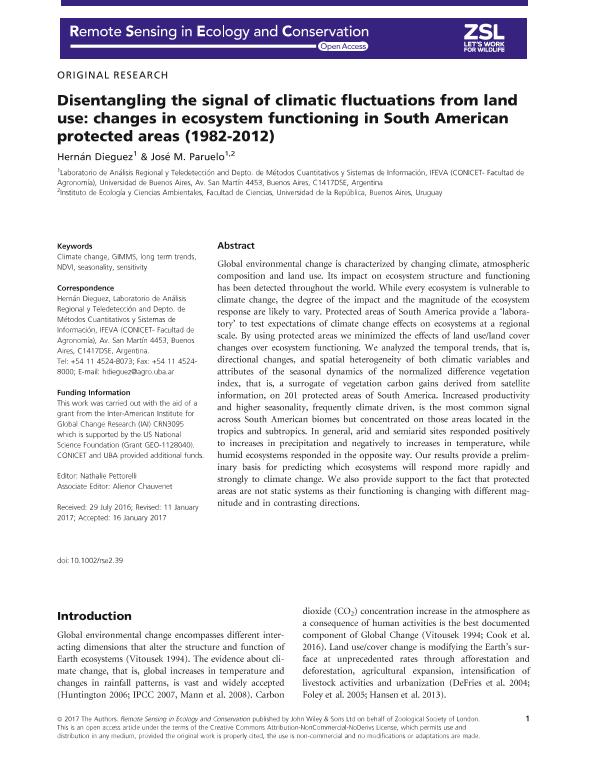Artículo
Disentangling the signal of climatic fluctuations from land use: changes in ecosystem functioning in South American protected areas (1982-2012)
Fecha de publicación:
12/2017
Editorial:
John Wiley & Sons Ltd
Revista:
Remote Sensing in Ecology and Conservation
e-ISSN:
2056-3485
Idioma:
Inglés
Tipo de recurso:
Artículo publicado
Clasificación temática:
Resumen
Global environmental change is characterized by changing climate, atmospheric composition and land use. Its impact on ecosystem structure and functioning has been detected throughout the world. While every ecosystem is vulnerable to climate change, the degree of the impact and the magnitude of the ecosystem response are likely to vary. Protected areas of South America provide a ‘laboratory’ to test expectations of climate change effects on ecosystems at a regional scale. By using protected areas we minimized the effects of land use/land cover changes over ecosystem functioning. We analyzed the temporal trends, that is, directional changes, and spatial heterogeneity of both climatic variables and attributes of the seasonal dynamics of the normalized difference vegetation index, that is, a surrogate of vegetation carbon gains derived from satellite information, on 201 protected areas of South America. Increased productivity and higher seasonality, frequently climate driven, is the most common signal across South American biomes but concentrated on those areas located in the tropics and subtropics. In general, arid and semiarid sites responded positively to increases in precipitation and negatively to increases in temperature, while humid ecosystems responded in the opposite way. Our results provide a preliminary basis for predicting which ecosystems will respond more rapidly and strongly to climate change. We also provide support to the fact that protected areas are not static systems as their functioning is changing with different magnitude and in contrasting directions.
Palabras clave:
Climate Change
,
Gimms
,
Long Term Trends
,
Seasonality
,
Sensitivity
,
Ndvi
Archivos asociados
Licencia
Identificadores
Colecciones
Articulos(IFEVA)
Articulos de INST.D/INV.FISIOLOGICAS Y ECO.VINCULADAS A L/AGRIC
Articulos de INST.D/INV.FISIOLOGICAS Y ECO.VINCULADAS A L/AGRIC
Citación
Dieguez, Hernan Dario; Paruelo, José; Disentangling the signal of climatic fluctuations from land use: changes in ecosystem functioning in South American protected areas (1982-2012); John Wiley & Sons Ltd; Remote Sensing in Ecology and Conservation; 3; 4; 12-2017; 177-189
Compartir
Altmétricas




